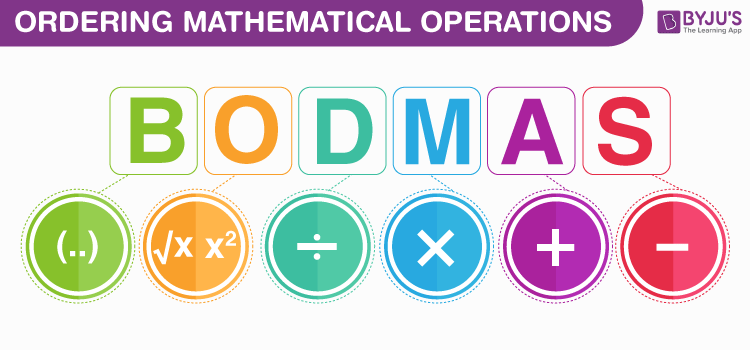
An arithmetic expression that involves multiple operations such as addition, subtraction, multiplication, and division are not easy to solve as compared to operations involving two numbers. An operation on two numbers is easy, but how to solve an expression with brackets and multiple operations and how to simplify a bracket? Let’s recollect the BODMAS rule and learn about the simplification of brackets.
What is BODMAS RULE?
BODMAS is an acronym and it stands for Bracket, Order, Division, Multiplication, Addition, and Subtraction. In certain regions, PEMDAS (Parentheses, Exponents, Multiplication, Division, Addition, and Subtraction) is used, which is the synonym of BODMAS. Thus, the order of operations of BODMAS and PEMDAS is shown in the below figure.
BODMAS Rule Explanation
It explains the order of operations to be performed while solving an expression. According to the BODMAS rule, if an expression contains brackets ((), {}, []) we have first to solve or simplify the bracket followed by ‘order’ (that means powers and roots, etc.), then division, multiplication, addition and subtraction from left to right. Solving the problem in the wrong order will result in a wrong answer.
The BODMAS rule can be applied, if the expression involving more than one operator. In this case, first, we have to simplify the terms inside the bracket from the inner most bracket to the outermost bracket [{()}], and simplify the roots or exponents, if any. Then perform multiplication or division operation from left to right. Finally, perform addition or subtraction operation to get the accurate answer.
Note: The “O” in the BODMAS full form is also called “Order”, which refers to the numbers which involve powers, square roots, etc. Check the examples below to have a better understanding of using the BODMAS rule.
BODMAS Rule Full form
As we mentioned earlier, the full form of BODMAS is Brackets, Orders, Division, Multiplication, Addition, Subtraction. While applying the BODMAS rule we should follow the order of these operations.
This order must be followed to get accurate results.
BODMAS Rule has been explained in this video along with various examples. Watch this video to get completely acquainted with the BODMAS or PEDMAS rule and solve any maths equation effectively.
What is BODMAS Rule?
BODMAS stands for Bracket, Of, Division, Multiplication, Addition, and Subtraction. The BODMAS is used to explain the order of operation of a mathematical expression. In some regions, the BODMAS is also known as PEDMAS which stands for Parentheses, Exponents, Division, Multiplication, Addition, and Subtraction.
According to BODMAS rule, the brackets have to be solved first followed by powers or roots (i.e. of), then Division, Multiplication, Addition, and at the end Subtraction. Solving any expression is considered correct only if the BODMAS rule or the PEDMAS rule is followed to solve it.
Example Question Using BODMAS Rule:
Take the following questions:
(3+5)-5+2
To solve this, the first bracket has to be solved which will give the following-
(8)-5+2
Now, an addition has to be solved:
(8)-7 = 1.
Sometimes you may also come across percentages while simplifying the numerical expression using this BODMAS rule.
Conditions and Rules
A few conditions and rules for general simplification are given below:
Tips to Remember BODMAS Rule:
The rules to simplify the expression using BODMAS rule are as follows:
- First, simplify the brackets
- Solve the exponent or root terms
- Perform division or multiplication operation (from left to right)
- Perform addition or subtraction operation (from left to right)
BODMAS Rule Solved Examples
Example 1:
Solution-
Step 1: Solving the fraction inside the bracket first-
Step 2: Now the expression will be (3/4) of 16
Simplification of Brackets
Simplification of terms inside the brackets can be done directly. That means we can perform the operations inside the bracket in the order of division, multiplication, addition and subtraction.
Note: The order of brackets to be simplified is (), {}, [].
Example 2:
Simplify: 14 + (8 – 2 × 3)
Solution:
14 + (8 – 2 × 3)
= 14 + (8 – 6)
= 14 + 2
= 16
Therefore, 14 + (8 – 2 × 3) = 16.
Example 3:
Simplify the following.
(i) 1800 ÷ [10{(12−6)+(24−12)}]
(ii) 1/2[{−2(1+2)}10]
Solution:
(i) 1800 ÷ [10{(12−6)+(24−12)}]
Step 1: Simplify the terms inside {}.
Step 2: Simplify {} and operate with terms outside the bracket.
1800 ÷ [10{(12−6)+(24−12)}]
= 1800 ÷ [10{6+12}]
= 1800 ÷ [10{18}]
Step 3: Simplify the terms inside [ ].
= 1800 ÷ 180
= 10
(ii) 1/2[{−2(1+2)}10]
Step 1: Simplify the terms inside () followed by {}, then [].
Step 2: Operate terms with the terms outside the bracket.
1/2[{−2(1+2)}10]
= 1/2 [{-2(3)} 10]
= 1/2 [{-6} 10]
= 1/2 [-60]
BODMAS Rule without Brackets
The BODMAS rule can be applied to solve the mathematical expression without brackets too. Consider the following question to verify.
Example 4:
Simplify: 17 – 24 ÷ 6 × 4 + 8
Solution:
17 – 24 ÷ 6 × 4 + 8
As per the BODMAS rule, we should perform the division first.
17 – 4 × 4 + 8
Let’s perform the multiplication.
17 – 16 + 8
Finally, addition and subtraction.
25 – 16 = 9
Example 5:
Simplify the expression: 1/7 of 49 + 125 ÷ 25 – 12
Solution:
1/7 of 49 + 125 ÷ 25 – 12
= (1/7) × 49 + 125 ÷ 25 – 12
= 7 + 125 ÷ 25 – 12
= 7 + 5 – 12
= 12 – 12
= 0
Solved Problems On Bodmas
Question 1: Solve 8 + 9 ÷ 9 + 5 × 2 − 7.
Solution:
The problem given is 8 + 9 ÷ 9 + 5 × 2 − 7.
The division operation is performed first.
9 ÷ 9 = 1
So, the expression reduces to 8 + 1 + 5 × 2 − 7
The multiplication operation is taken next,
5 × 2 = 10
So, the expression reduces to 8 + 1 + 10 − 7
The addition operation is
8 + 1 + 10 = 19
The final answer is 19 – 7 = 12.
Question 2: Simplify the expression [25 – 3 (6 + 1)] ÷ 4 + 9.
Solution:
The problem given is [25 – 3 (6 + 1)] ÷ 4 + 9.
The round bracket is (6 + 1) = 7.
The next bracket is 3 (7) = 21
Take [25 – 21] ÷ 4 + 9
(25 – 21) = 4
Then division operation is performed,
4 ÷ 4 = 1
Then 1 + 9 = 10
The final answer is 10.
Question 3: Solve (1 / 4 + 1 / 8) of 64.
Solution:
In the first step, consider (1 / 4 + 1 / 8) = (2 + 1) / 8 = 3 / 8
Take (3 / 8) of 64
Here the term “of” refers to the operation of multiplication.
(3 / 8) of 64 = (3 / 8) * 64
= 24
Question 4: Simplify the given expression: 180 ÷ 15 {(12 – 6) – (14 – 12)}.
Solution:
Initially, the first ( ) brackets are simplified,
180 ÷ 15 {(12 – 6) – (14 – 12)}
= 180 ÷ 15 (6 − 2) (solve round bracket)
= 180 ÷ 15 (4) (solve curly bracket)
= 12 (4) (divide 180 by 15 = 12)
= 12 × 4 (if no operator is mentioned behind any given bracket, multiplication operation can be performed)
= 48
The final answer is 48.
Question 5: Simplify the following expression 3 + 24 × (15 ÷ 3) using the BODMAS rule.
Solution:
The expression given is 3 + 24 × (15 ÷ 3).
The bracket is taken first.
(15 ÷ 3) = 5
Then 3 + 24 × 5
The calculation is done in order 24 = 2 × 2 × 2 × 2 = 16
16 × 5 = 80
The addition operation is performed next.
3 + 80 = 83
The final answer is 83.
Question 6:
Solution:
First consider the vinculum or line bracket 16 [8 – {5 – 2 (1 + 1)}] = 16 [8 – {5 – 2 * 2}] ( solve the curved bracket)
= 16 [8 – {5 – 4}]( multiply the curly bracket )
= 16 [8 – 1] ( solve the curly bracket)
= 16 * 7 ( solve the inner part of the square bracket)
= 112
Hence, the final answer is 112.
Question 7: Solve the expression using BODMAS rule{50 – (2 + 3) + 15}.
Solution:
Input Equation:
= {50 – (2 + 3) + 15}
= {50 – (5) + 15}
= {50 – 5 + 15}
= {45 + 15}
= {60}
= 60
Question 8: Simplify the expression using the BODMAS rule [18 – 2 (5 + 1)] ÷ 3 + 7.
Solution:
Input Equation can be rewritten:
= [18 – 2 * (5 + 1)] / 3 + 7
= [18 – 2 * (6)] / 3 + 7
= [18 – 2 * 6] / 3 + 7
= [18 – 12] / 3 + 7
= [6] / 3 + 7
= (6 / 3) + 7
= 2 + 7
= 9









0 Comments